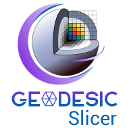Documentation/4.8/Modules/GeodesicSlicer
|
For the latest Slicer documentation, visit the read-the-docs. |
Introduction and Acknowledgements
|
The module has been developed based on ideas and feedback from the community. We would like to especially thank:
- Dr. Olivier Etard, M.D., Ph.D., CHU de Caen.
- Dr. Sonia Dollfus, M.D., Ph.D., CHU de Caen, header of ISTS.
- Dr. Csaba Pinter, MSc, Queen's University.
- Dr. Andras Lasso, Ph.D., Queen's University.
Contents
Module Description
This module calculates geodesic path in 3D structure. Thanks to this geodesic path, this module could draw an EEG 10-20 system.
Terminology
- Mesh A mesh or polygon mesh is a collection of vertices, edges and faces that defines the shape of a polyhedral object in 3D computer graphics and solid modeling.
- Shortest path In graph theory, the shortest path problem is the problem of finding a path between two vertices (or nodes) in a graph such that the sum of the weights of its constituent edges is minimized.
- 10-20 EEG system The International 10-20 system is commonly used for EEG electrode placement and for correlating external skull locations to underlying cortical areas.[1]
Use Cases
The overall goal is to allow users to find the shortest paths between nodes in a graph and via the Dijkstra's algorithm to make 10-20 system. This module can be used for:
- Stimulation in psychiatry
- surgery measurement
- 3D printing
Panels and their use
Create a mesh
Image à insérer: "wiki_main_picture2.png"
A typical straightforward Geodesic Slicer workflow for consists of the following steps:
- Load a volume.nii.
- Enter the Geodesic Slicer module using either the toolbar or the Modules menu button.
- Create a mesh.
- Wait a moment
- Use this mesh.
- If your background was named 't1' the label will be called 't1-label'.
- Go to Parameters to find the shortest path or Make 10-20 EEG system electrode section.
Parameters to find the shortest path
- Source points.
- Input STL model.
- Calculate in centimeter the shortest path via the Dijkstra's algorithm.
- Draw the Dijkstra's algorithm shortest path.
- Length (cm)
10-20 system electrode
Run the Dijkstra's algorithm to make the 10-20 system electrode distances
4 anatomical landmarks
Four anatomical landmarks are used for the essential positioning of the electrodes:
- 1/the nasion
- 2/the inion
- 3/the pre auricular to the left ear
- 4/the pre auricular to the right ear
Input STL model
This model required to contain a dense set of points.
Make 10-20 EEG system electrode
Make 10-20 EEG system electrode via the Dijkstra's algorithm.
- Distance T3-Stim in the T3P3 axis are give in centimeters.
Information for Developers
The code is available at Github.
References
- ↑ Jasper, H.H. The ten-twenty electrode system of the International Federation. Electroencephalogr. Clin. Neurophysiol., 1958, 10: 370-375


